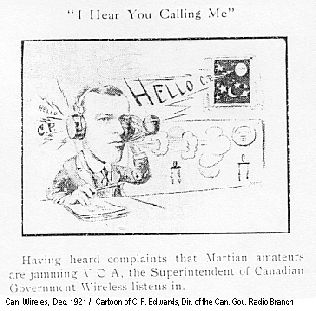
|
Spectrum Management - From the Early Years to the 1990s |
|
Page 10 of 26 Radio Frequency Interference |
|
The increase in cases of radio frequency interference in the general public followed the growth in the number of radio transmitting stations. Industrialization also contributed because many appliances and factories use HF current in their processing or manufacturing methods, as well as the medical field where instruments are used to diagnose or treat some illnesses.
Radio and television reception can also be affected by radio transmissions. The interference will vary depending on the situation.
In the case of radio, communications from the interfering station are heard more or less clearly, or the reception of the desired station is completely blocked.
In the case of television, interference can be seen in different ways on the screen. The image may be altered to show a herringbone pattern, or there may be a ghost image, vertical or horizontal scrolling of the image, reversals of black or white, horizontal or vertical lines of varying rates, a disruption in synchronization and others. Sometimes the interference can be heard on the audio channel of the television set.
Amateur radio has often been blamed and sometimes the only solution to the problem has been to restrict the hours of transmission or the HF power used. Many amateur radio clubs have formed committees to help people find solutions for interference that is affecting their reception.
With the mass arrival of General Radio Service (GRS or CB radio), the number of requests for assistance submitted to the Department increased significantly. It can be said that within a radius of 200 to 500 metres of a GRS station, most radios, record players, audio amplifiers, telephones, tape recorders and similar devices were likely affected by a fairly significant level of interference that could usually be eliminated by adding a simple filter to the device, or by making a minor modification to the receiving installation. This was something that should have been foreseen in any event, and done when the device affected by interference was being installed or manufactured.
A few investigations involving problems of this sort even resulted in legal action where the Department's inspectors were called upon to testify.
After publishing a Notice in June 1990 on the compatibility of mass-produced equipment, in 1994 the Department launched an awareness program for repair shops and prepared or revised many information bulletins on various methods for solving interference problems (examples appended). Criteria and standards relating to interference-causing equipment followed.
In 1996, interactive documents in the "Cutting Through..." series dealing with various kinds of interference were published in multimedia format and posted on the Department's Web site at http://strategis.ic.gc.ca/ssgf/. A wide range of documents on interference and other subjects is also available at:
http://strategis.ic.gc.ca/epic/internet/insmt-gst.nsf/en/home?
On April 1, 1997, the Department revised the process related to handling requests for assistance from the public. Henceforth, we advised people submitting requests that the Department did not provide assistance in solving interference problems except to make the appropriate documentation available to them. However, if it could be shown that a lack of co-operation from the owner of the equipment causing the interference was preventing a solution to the problem, the Department could intervene.
A set of brochures in the "Cutting Through..." series was also published. Various types of computer-based presentations to help solve some interference problems have also been made available.
In the 1960s in urban areas, spectrum congestion due to radio communication systems rapidly forced the Department to review its methods for selecting frequencies and authorizing stations, precisely to prevent interference before it occurred.
A thorough technical analysis of applications, obliging stations to be equipped with elaborate filter systems, and strict control over the transmitting power are some of the ways this was accomplished.
History repeats itself eternally, and it will always be difficult for some to explain a phenomena in a way that is easily understood by the average citizen, as shown by an article dated 09/11/2002, entitled "Le train de Deux-Montagnes produit des harmoniques" (the Deux-Montagnes train produces harmonics) and published under the by-line of Bruno Bisson in the daily paper, La Presse. It has a number of similarities to the history of Roberval published in 1892! An excerpt follows.
[translation] "The production of harmonics is a normal phenomenon resulting from the use of any electric appliance. A vacuum cleaner, or the surge of current for an air conditioner or a dryer, for instance, can produce harmonics - "electric vibrations" that reverberate in the appliances themselves, are transmitted to the power supply and can travel all the way back to the power grid if they are strong enough.
By the way, if these
harmonics happen to bounce into the relay of a power system that is installed
close to a telephone network relay, the telephone subscribers will be able to
hear some interference, like a noise resembling an electric razor, explained Mr.
Losique.
Nonetheless, Agence métropolitaine de transport has already spent $570,000 to protect the train's signalling system from the effects of these harmonics.
In 1995, the new Deux-Montagnes train was inaugurated. It was originally a regional train that had been built in World War I to connect the Lower Laurentian region and Montreal, and it has always been powered by electricity.
Since 1918, the train
had been powered by a 3,000-volt direct current line. But Hydro-Québec's modern
power lines provide an alternating current on higher voltage lines. The train
was therefore converted so that it could be powered by a 25,000-volt line. All
the rolling stock had to be adapted accordingly.
According to Mr. Losique, these harmonics, which mutually amplify themselves to up to 11 times the electrical cycle (60 hertz), perturb the flow of current between the train's line and the Hydro-Québec network, and do not allow the train to achieve the energy performance expected following the upgrade.
These electric vibrations also have an impact on Hydro-Québec's power grid, which has standards for these harmonics. Presently, admitted Mr. Losique, the Deux-Montagnes train does not always meet Hydro-Québec requirements. Replacing some of the power equipment on the Deux-Montagnes train could nevertheless be enough to damp out these harmonics in order to meet the standards and eliminate the disturbances."
Locating interference is still one of the Department's numerous activities.
Today, the emphasis is on last resort assistance, when it has been determined that there is harmful interference and after those requesting help have exhausted all other avenues, including documentation on the subject, amateur radio clubs and interference committees, repair shops and suppliers of radio communication equipment.
|
|
Spectrum Management - From the Early Years to the 1990s |







